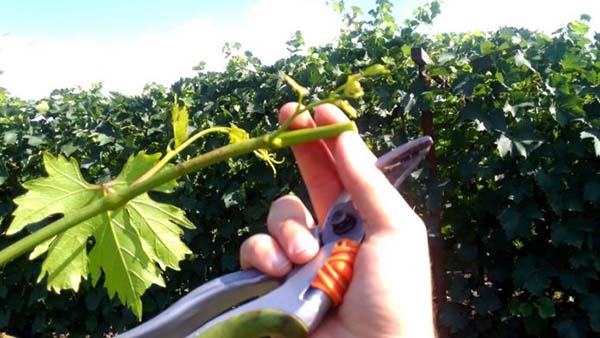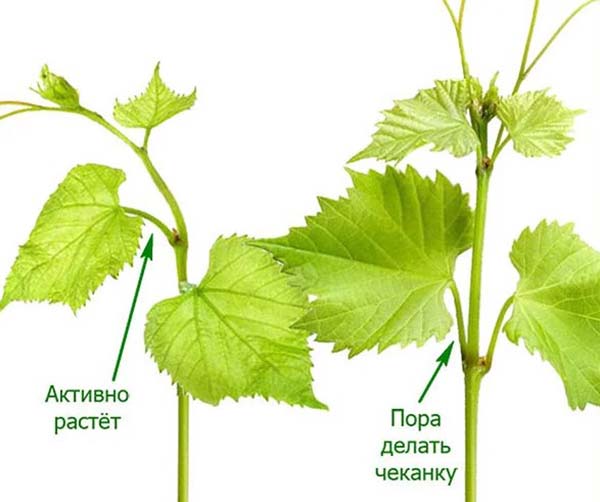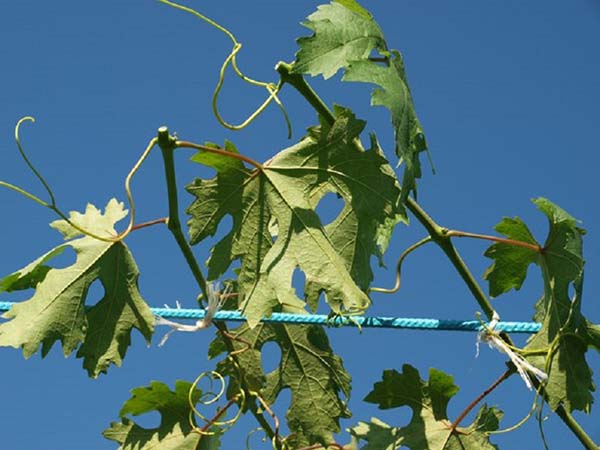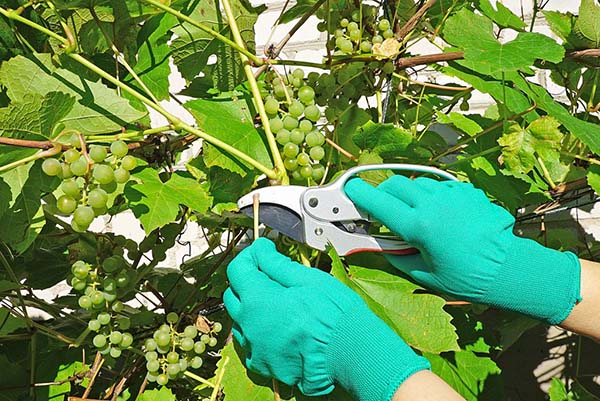How to mint grapes correctly in summer and autumn (in July and August) - tips for summer pruning for beginner winegrowers
Many budding growers want to know whether to mint grape shoots in summer and autumn. However, there is no consensus about the summer minting of grapes: one part of the growers categorically rejects the shortening of the tops of the shoots, the other part believes that it is simply necessary.
Next, we will consider what grape chasing is, what advantages and disadvantages it has, as well as when and how to properly shorten (pinch) the shoots before flowering, in summer and autumn.
Pinching and chasing are not the same thing. Although minting is often called a special type of pinching.

Content
- 1 How to prune grapes in summer: pinching, summer chasing and other green operations (pinching, mustache removal)
- 2 What is embossing (shortening) of grape shoots, its advantages and disadvantages: when and how to mint correctly
- 3 Grape growing, whisker removal and other summer (green) grape pruning operations
How to prune grapes in summer: pinching, summer chasing and other green operations (pinching, mustache removal)
Summer pruning of grapes provides for the following green operations (that's why they also say "green pruning of grapes"):
- pinching (before or at the beginning of flowering, i.e. at the beginning of summer - around June);
- minting (summer in July and autumn in August);
- pinching (after flowering and during the entire period while the plant is pinching);
Important! Read more about pinning in this separate article.
- removal of whiskers and other green operations (removal of part of the leaves in the fruit zone in autumn after the heat, as well as thinning of inflorescences and / or brushes, fragment of shoots).
By the way! When they talk about summer pruning of grapes, as a rule, they mean exactly the minting of shoots, as well as sometimes pinching (we repeat, pinching and stamping are by no means the same).
Pinching grapes
The tops of the shoots (growth points) are pinched before flowering (or only at the beginning of flowering) in order to redirect food to the flower brushes. In other words, by pinching the tops (growth points) of the grapes, you can improve the quality of the ovaries, reduce their shedding and increase the number of berries in the bunch.
As a rule, pinching is necessary only for those grape varieties that are poorly pollinated and / or their ovary crumbles heavily (that is, this is the same Radiant Kishmish, Strashinsky, but you don't need to pinch Arkady).
Important! You should not pinch the tops of fruiting shoots on bushes and varieties that have weak growth, as well as on those table varieties for which the looseness of the bunches is desirable.
It is worth understanding! Pinching won't remove the peas!

By the way! Also, pinching (more precisely, pinching) is subject to the lower stepsons (but the uppermost stepson must be left), because after removing the top, the plant will direct its nutrition not only to the inflorescences (future berries), but also to the formation of lateral shoots (stepsons). Therefore, thanks to their (stepsons) removal (more precisely, pinching), you will be able to restrain their growth for 5-7 days (this is just enough for the bunch to start), and then the upper stepson will wake up, which will become a continuation of the escape.
Video: pinching the tops of grape shoots
Note! Pinching grape shoots, like chasing (which we will talk about later), provoke (activate) the growth of stepsons.
Therefore, it is believed that pinching is an absolutely pointless operation that does not significantly change anything. The fact is that there are enough plastic substances for the plant during flowering (as can be seen from the stepchildren, who at this time begin their intensive growth). Therefore, when you pinch the growth point (crown), the stepsons will strive to take its place, i.e. you yourself will provoke a thickening of the bush, which means that you will have to pinch again (summer and autumn minting).
What is embossing (shortening) of grape shoots, its advantages and disadvantages: when and how to mint correctly
Chasing grapes is the shortening of a significant part of the shoot, including part of its underdeveloped leaves, namely, its upper part to the first normally developed leaf.
Interesting! But pinching the shoots (as mentioned above) is the removal of only their tops, and it is just before flowering or at the beginning. However, these terms are often used erroneously - as synonyms, which is completely wrong.

Video: summer (chasing) shortening grape shoots
When to carry out summer and autumn chasing of shoots
The main signal for the beginning of the autumn minting of grape bushes is straightening of crowns apices (before that they were bent), which means the end of the active (intensive) growth of shoots.

Note! If the crowns are straightened at the beginning or in the middle of summer, then you have an obvious overload of crops or shoots, or your bush does not receive additional nutrition (watering, top dressing).
Thus, with regard to the approximate timing of the autumn minting of grapes, then usually it is produced at the moment the berries begin to ripen, i.e. in the beginning or second half August.
And here summer minting of grapes can (and should be done if necessary) much earlier, focusing not on the timing, but at the moment when the vine outgrows your trellis, i.e. more late June - July.
Important! In general, it can be easy to get confused, because autumn chasing is performed at the end of summer, and summer chasing in the middle or second half. However, it is worth remembering that it just so happens that the month of August in horticulture, as a rule, refers to autumn.
Video: when to carry out the autumn minting of grapes
Note! Regarding the autumn minting of grapes, unnecessary questions usually do not arise, because its purpose is to improve the ripening of the vines and a good wintering of bushes (especially important for the "northern" growing regions, as well as for mid-late and late varieties).
Summer chasing of grapes is another matter. Here, the controversy does not subside, and there is no consensus.
Why summer minting is not recommended and what to do with long vines
It is believed that the summer chasing negatively affects the productivity of grapes, therefore, many winegrowers regard it as a harmful event (this does not apply to autumn minting).
The fact is that by shortening the shoots, together with them we remove some leaves, thereby weakening the bush - reducing its yield.
As a rule, it is considered on average that a bunch weighing 1 kg requires about 1 sq. M. leaf area, which is about 25 leaves.
It is worth understanding! There can be no harvest without leaves.
The longer the shoot, the more leaves it has - a source of nutrients. The larger the green mass, the more powerful the roots and the more powerful the shoots. Accordingly, bunches are larger on powerful shoots, because more leaves feed them.
Also summer coinage stimulates more active growth of stepchildren.
Stepchildren are additional shoots that form from the leaf axils.
So what is recommended to do with long shoots?
Some growers advise to lay the shoots along the top wire, which should have a positive effect on the illumination of the bush, as well as on its productivity (more leaves remain = more harvest).
It is worth considering! If you plan to do this, then the height and length of your trellis should be sufficient (certainly more than 2-2.5 m) meters in height, i.e. about about 3 meters.
Moreover, it should be borne in mind that in the case of a "good" wind, the upper wire can simply burst and then you will have to untangle the intertwined vines, in other words, the structure must be strong. In addition, it is important to take into account the fact that strong winds can simply fill up the entire trellis, because due to the excessive amount of leaves, it will have a huge windage.
What are the advantages of summer coinage
The arguments “for” carrying out the minting of grape shoots in summer are as follows:
- If do not mint shoots (and do not lay them along the upper wire), then the bush thickens too much, extra shoots will simply close the fruit-bearing vines (like curtains), which will increase the humidity inside (due to poor ventilation), which means that an outbreak of the same oidium or mildew, and then in the end you may be left without part of the harvest.
In addition, young shoots and leaves are more susceptible to various diseases. In other words, under unfavorable conditions, they are hit first.
By the way! If the weather is favorable, then minting may not be performed; another thing to do pinching.
- Thanks to the minting, you will be much more convenient to take care of the bush, including spray against disease.
- By shortening the tops of young shoots, you thereby redirect all the forces of the bush for the ripening of the crop and the ripening of the vine.
- It is also believed that pinched leaves can replace thosewhich you remove from the main stem when minting.
Interesting! Moreover, some believe that the leaves on the stepsons are even more effective than on the main shoot. Of course, if these leaves will be well lit and not shaded or shaded by others. In other words, you can increase the total leaf area by increasing the length of the stepchildren (i.e. the number of leaves on them).
Thus, the summer chasing of grape shoots is a necessary (sanitary) measure, thanks to which your vineyard will not thicken.
In other words, vigorous grape varieties must be minted without fail, but you cannot pinch the weak ones, otherwise they simply will not have enough food (leaves) to ripen the harvest.
Opinion! “The fact that the yield drops during minting is absolute nonsense. The fact is that when chasing the power of the bush goes all into the berry, which means that the yield, on the contrary, increases, while the rate of ripening also increases. "
How to properly chase shoots
As a rule, in the summer, only the upper part of the shoot that has grown above the upper wire of the trellis is minted (removed). At the same time, 2-4 more leaves are left above, of which one strong stepson grows.

In other words, they cut it as high as they reach it by hand (as a rule, about 2-2.5 meters), because it is according to this principle that the trellis is usually made (more precisely, its height is determined).
How exactly should be minted? It's simple: take it with your hands and break off (pinch) the excess upper part of the shoots. You can also use a pruner.
By the way! There is an interesting way of minting according to Kurdyumov. So you need to take the top of the shoots in the hands and determine by touch: if the leaves are soft = young - remove, harder - old, they should be left.
What to do after the summer coinage
Due to the fact that after pinching the upper shoots, the grape bushes experience a certain stress, which can lead to catching any fungal disease, for preventive purposes, treatment of the vine with one of the fungicides.
Also closer to autumn, it is recommended to start potassium-phosphorus fertilizing (both under the root and on the leaves).
Grape growing, whisker removal and other summer (green) grape pruning operations
Important! The site already has a detailed article about when and how to pinch grapes.
It is believed that the whiskers are underdeveloped (false) inflorescences (bunches), which means that they also take on a part of the nutrition (very small). But the main reason for their removal, as a rule, is the fact that they firmly cling to shoots or a trellis, which can cause some inconvenience.
Video: why remove antennae on grape shoots
By the way! The mustache has one peculiarity: when the green shoot moves to a horizontal position, the mustache dries up by itself.
Also, as the grape clusters ripen (during the period of sugar collection, on the softened berry), the lower leaves should be removed (they also say "mint leaves") so that the bunches are well illuminated by the sun, colored better, they accumulate more sugars and they mature faster.

Well, we hope that now you know why and how grapes are pruned in summer, which means that you can independently decide whether you need summer chasing for your grapes or it is better to leave everything as it is, and at the same time do active pinching, so that later , already in August, to carry out the autumn coinage.
Note! Basic grape pruning do once late autumn or in early spring in early spring (usually in the case of uncovered grapes). In the summer, we spend green operations, namely pinch, mint, pinch, remove all unnecessary and damaged (diseased leaves).
Video: summer and autumn chasing of vines

